mite achimowin (Heart Talk): First Nations Women Expressions of Heart Health
Updated October, 2019
The mite achimowin (Heart Talk): First Nations Women Expressions of Heart Health study received funding from the CIHR (Canadian Institutes of Health Research; Aboriginal People’s Health Institute) and SSHRC (Social Sciences and Humanities Research Council) through the Urban Aboriginal Knowledge Network in partnership with Nanaandawewigamig. The study, which took place in Winnipeg over 2015-2016, was a collaboration between the University of Winnipeg and the University of Manitoba.
mite achimowin means ‘heart talk’ in Cree. The mite (heart) achimowin (talk) concepts carry wisdom of teachings that involve connections between a person’s physical body, mind and spirit. According to mite teachings, at birth the Creator provides a gift of the heart to every human being. It is recognized that there would be no life without the heart. It is where a person derives their emotions and intelligence. A holistic view of the heart includes an understanding of how to care for the psychological, spiritual, physical, and emotional wellbeing.
Doris Young and Esther Sanderson

There were two phases of the project. The first phase brought together six First Nations women from across Manitoba for one week. Over this period, the women participated in learning circle discussions to explore and express their experiences related to their own heart health or caring for a relative with a heart health issue. From these discussions, the women produced digital stories (3–5 minute videos) touching upon various themes affecting First Nations heart health including: transitions from traditional to westernized lifestyles and diets; the trauma of residential schools; racism; access to medical care; culturally unsafe health care; subjugation of culturally-rooted medicines, and economic and geographic marginalization.
The second phase involved presenting the videos to over 200 undergraduate students in medicine and nursing at the University of Manitoba. The students then participated in facilitated dialogue sessions so they could share their thoughts on the videos and discuss ways to integrate Indigenous concepts of mite (heart) knowledge and patients’ experiences with biomedical knowledge and practice. To learn more about the project, see the video mite achimowin: Heart Talk – First Nations Women’s Expressions of Heart Health Digital Story Research Project. This video introduces Indigenous and biomedical models that lend to heart health and wellness from the perspectives of the project collaborators and digital storytellers. Notably, the video and the digital stories point to the importance of relationships (wahkotowin) in order to be able to achieve mino-pimatisiwin (a good life).
 Lorena Fontaine, Annette Schultz and Lisa Forbes.
Lorena Fontaine, Annette Schultz and Lisa Forbes.
Also featured is a podcast recorded with the mite achimowin (Heart Talk) project team, including co-investigators Lorena Fontaine (University of Winnipeg) and Dr. Annette Schultz (University of Manitoba) and project coordinator Lisa Forbes. This audio recording provides an overview of the project and the main themes that resulted from the project. The research team acknowledges research collaborator Ivan Berkowitz, who enthusiastically introduced Lorena and Annette to each other and encouraged the mite achimowin project even in his final days.
Finally, a paper titled Understanding First Nations women’s heart health was developed to examine the context of First Nations women’s heart health with a specific view to understanding the role that colonization has played in the prevalence of and risk factors for heart diseases, and in diagnosing and treating them. The paper also looks to strategies that might help to close the gap in First Nations women’s heart health.
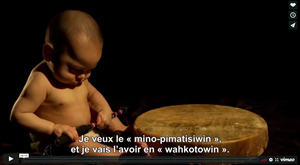 Introduction - Digital Story Research Project
Introduction - Digital Story Research Project
The short video mite achimowin: Heart Talk – First Nations Women’s Expressions of Heart Health Digital Story Research Project, provides an introduction to the project and Indigenous and biomedical models that lend to heart health and wellness.
Watch the video
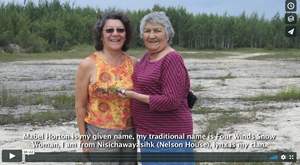 Christina Baker and Mabel Horton
Christina Baker and Mabel Horton
Christina Baker (right) and Mabel Horton (left) both live in Winnipeg. Christina is Cree from Split Lake (Tataskweyak Cree Nation) which is 900 kilometers north of Winnipeg. She and her family members have heart health issues. Mabel is Christina’s niece. She is Cree and a member of Nisichawayasihk First Nation (Nelson House) located 850 kilometers north of Winnipeg. She cares for family members with heart health issues. Their collaborative video features images from their family camp. They describe the importance of traditional foods, physical activity, and ways of being healthy. Christina and Mabel narrate their story in their first language – Cree – to talk of the importance today of eating well and keeping active.
Watch the video
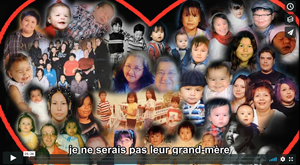 Eliza Beardy
Eliza Beardy
Eliza Beardy is Oji Cree from Wasagamack First Nation, Manitoba, a fly-in community 600 kilometers north of Winnipeg. She currently lives in Winnipeg and cares for family members with heart health issues. Eliza’s video features images of her parents, children, grandchildren, and great grandchildren as she describes the importance of family relationships and bonds to heart health. As a residential school survivor, she speaks of the lasting heart break experienced by parents and children as a result of separation due to residential schools.
Watch the video
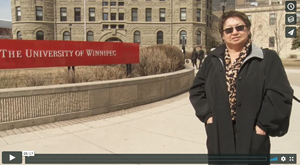 Virginia Mckay
Virginia Mckay
Virginia McKay is Saulteaux and lives in Berens River First Nation, Manitoba, which is a fly-in community 270 kilometers from Winnipeg. She and a family member have heart health issues. Virginia shares two short stories. The first describes the enduring love and pride of her grandchild and the importance of the family relationship and values. Her second story features the landscape of Berens River First Nation and a story of racial discrimination experienced by a family member as he sought medical care for a serious health issue.
Watch the video
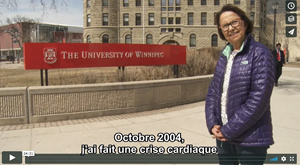 Esther Sanderson
Esther Sanderson
Esther Sanderson is Cree from Opaskwayak Cree Nation (the Pas, Manitoba). The Pas is 630 kilometers north of Winnipeg. Her video describes her personal journey of the spirit and mind during her heart transplant surgery. She also shares the importance of family bonds and cultural knowledge during her recovery.
Watch the video